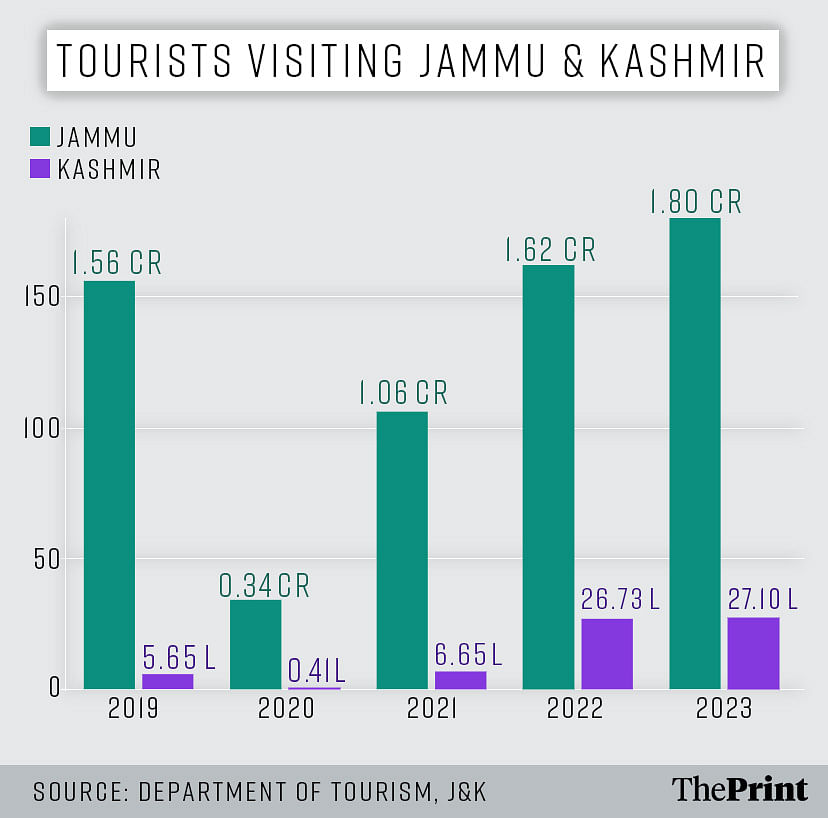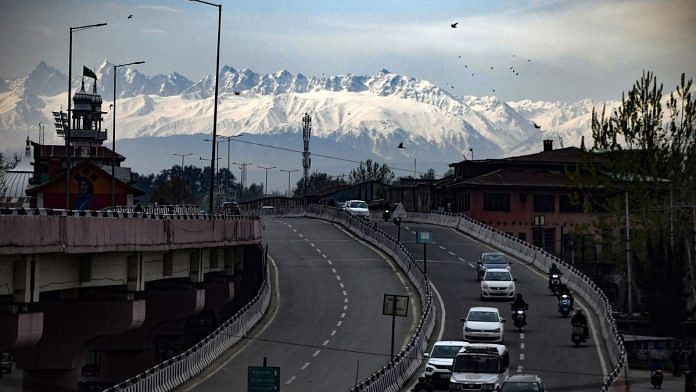Jammu: Not many cities can boast of having an IIT, an IIM and an AIIMS like Jammu. Though conceived before 2019, Prime Minister Narendra Modi inaugurated their permanent campuses in February. At the time of inauguration of AIIMS Jammu, Modi had said, “people of Jammu will no longer have to leave for Delhi to avail specialised medical treatment, which will help them save valuable time and resources.”
On 5 August 2019, Jammu and Kashmir witnessed a dramatic shift as Article 370 and 35A were scrapped and the erstwhile state divided into two Union Territories of Ladakh and Jammu & Kashmir. Since 2018, J&K has been under the Centre’s rule through a governor first and then the Lieutenant Governor. Much has changed since.
While Kashmir takes the spotlight, Jammu, too, has several new projects coming up, especially in the industrial sector since then. These may be significant changes, but are not necessarily a product of abrogation of Article 370.
The Centre came up with New Industrial Policy (NIP) 2021 for Jammu and Kashmir that came into effect 1 April 2021. Launched by L-G Manoj Sinha, the benefits of this policy have been largely drawn by the Jammu region, primarily the districts of Jammu, Kathua and Samba.
Currently, the groundwork of around Rs 20,000 crore worth of industrial units is already underway that have come up in the last three years and are registered under the policy, according to official figures of the J&K government accessed by ThePrint.
A further break reveals that over Rs 16,000 crore worth of investments (or, 80 percent) are in Jammu division alone, while the rest of investment is in Kashmir, which is less than a fifth of overall investment.
In 2023-24, the investment was Rs. 3,628 crore, of which Rs 1,966 crore was in Jammu. This was a rise of 68 percent when Rs 2,153 crore was invested in the UT, with Rs 1,416 crore from Jammu in 2022-23. The number of jobs created also went up from 10,506 in 2022-23 to 26,032 jobs in 2023-24 in the region. Investment went down in Covid year as it stood at Rs 376.76 crore in 2021-22, , across the UT.
These numbers also included “investment in respect of disbursed cases under the PMEGP’ — Prime Minister’s Employment Generation Program, a bank-financed subsidy programme for setting up new micro-enterprises in the non-farm sector. Maximum employment generated is because of this scheme.
They also show that despite the abrogation of Article 370, a lot of industrial investment is not going in Kashmir. Last year, the Jindal Steel Works laid the foundation stone of its plant in Pulwama.
Proud to announce that we have laid the foundation stone for our New Steel Procesisng unit in #Pulwama – the heart of #Kashmir !
Contributing to the growth of the beautiful state of #JammuKashmir @TheJSWGroup @PMOIndia @manojsinha_ @AmitShah pic.twitter.com/4y7hBH86In
— Sajjan Jindal (@sajjanjindal) February 16, 2023
“There are four components to the NIP. In the capital investment, we give 30 percent return in eligible plant and machinery, up to Rs 5 crore. In the service sector, the upper cap is Rs 7.5 crore. Second is capital interest subvention: term loan on eligible plant and machinery. A 6 percent term loan will be given by the government. If you have taken a loan on 9 percent, the government will return you six percent,” explained Director Industries of Jammu division, Arun Manhas.
“For existing units, we give 5 percent of working capital as an incentive. And the most lucrative policy is about GST. We give 300 percent GST-linked incentives. For example, if the eligible plants and machinery are invested worth Rs 100 crore. That means you will get Rs 300 crore worth of incentive over 10 years — 40 quarters. You can take Rs 30 crore each year. These incentives are there for anyone — within or outside the UT — registered under the policy.”
Asked how the investment has changed post 2019, Manhas said, “There was a psychological window that has opened. People feel more secure. Psychological blockage has opened.” He added, “No part of the country gives this kind of incentives.”
Industries especially from sectors of packaging, FMCG and pharmaceutical have made their way, with pharmaceutical giants including Cadilla, Torrent and Sun exporting their formulations from here.
“Ceylon Beverage has got land recently. They are making canned products. We will be getting $120 million of FDI…. Rs 1,350 crore worth of investment,” Manhas said.
While Manhas believes soon tourism industry will also pick up in the far-off areas of Jammu, tourism has also picked up over the last few years
Another senior J&K official told ThePrint that the NIP was behind the spurt in industrial activities.
”August 2019 changes had little to do with the rise in industries. It is purely this lucrative industrial policy that has given rise to industries in Jammu. Owing to security concerns and increased freight, people prefer their industries in Jammu than Kashmir,” the official said. “However, we are unable to make the most of the employment generated. There is a substantial lack of skilled labour in Jammu because of which people from outside take jobs.”
Also Read: Splintered Opposition, BJP consolidation & Article 370 — dynamics in play in J&K as Udhampur votes
Uptick in tourism
The Jammu division has seen a significant rise in tourism post 2019. According to the J&K government data, tourism has seen a rise of 15 percent between 2019 and 2023, . While in 2019, 1.56 crore tourists visited the Jammu division, primarily for pilgrimage purposes, the number rose to 1.80 crore in 2023.
Though Covid hit tourism in 2020 (34.3 lakh) and 2021 (1.06 crore), the sector quickly recovered to surpass the pre pandemic levels.

In all these years, Jammu accounted for the largest chunk of tourists, unlike the popular belief. According to the data, between 2020 and 2023, 88 percent tourists in Jammu & Kashmir visited the Jammu division. This is in continuation with the past trend.
A major shot in the arm for pilgrimage in Jammu came in when Tirupati Balaji temple opened its doors to visitors in June last year. Located at the outskirts of Jammu city, the temple is built on 62-acre land at an estimated cost of Rs 30 crore and is one of the largest temples in the Jammu region. It is further expected to boost religious and pilgrimage tourism in the union territory.
Boost in railway
Construction of roads and tunnels are a usual sight in the region. But the major boost has come in the form of railways. While rail connectivity is set to connect Srinagar with the rest of the country through Udhampur-Srinagar-Baramulla Rail Link, it has already reached Sangaldan.
In February, the PM inaugurated the Banihal-Sangaldan stretch which means the train services from Baramulla to Banihal will now be extended up to Sangaldan, a town near the district headquarters of Ramban.
This provides an alternative for road travelers stuck on the national highway between Ramban and Banihal due to landslides.
In December last year, Katra became one of the few cities in the country where two Vande Bharats have come up, connecting it with New Delhi. Katra serves as the base camp for pilgrims who wish to visit the Vaishno Devi shrine. The first Vande Bharat came way back in 2019, one of the first few Vande Bharats in the country.
While the G-20 event and F-4 racing event in Kashmir drew the attention of masses, Jammu, too, pulled off important milestones in hosting the T20 Legends League, which might have gone unnoticed last year. The sporting event marked a return of international cricket after 35 years.
Also read: In J&K’s Udhampur, Congress demands Article 371 as BJP trumpets 370 abrogation
Recognition to deprived groups
After the abrogation of Article 370, certain communities in J&K are set to get voting rights for the first time ever in the assembly elections. Most beneficiaries here will be those in the Jammu region.
The Valmikis, now a part of Scheduled Caste, have been residing in Jammu since the 1950s, when Bakshi Ghulam Mohammad’s government got them from Punjab for manual scavenging. But they never got voting rights since they came from outside. They are all concentrated in the Jammu city and are few thousands in number.
Another community that has benefited is the West Pakistan refugees, who now have voting rights in line with the rest of the country.
According to the Ministry of Home Affairs, West Pakistani Refugees (WPRs) are those who migrated from areas in West Pakistan in 1947 and settled in the erstwhile state of J&K, mainly in Jammu, Kathua and Rajouri districts.
“The 5,764 migrated families were not treated as Permanent Residents in the erstwhile State of Jammu & Kashmir. Though the WPRs are citizens of India and have the right to vote in parliamentary elections, they did not have the right to vote in the assembly and local body elections,” the MHA notes. “They did not have the right to purchase property in the erstwhile state. The children of these WPRs could not take admission in the technical and professional institutions of the erstwhile state.”
“After (abrogation of Article) 370, we have got citizenship of Jammu & Kashmir which is the biggest thing. We were fighting for that and we didn’t have voting rights in a democracy. That was a major issue. If you didn’t have permanent residentship. How will that person work in Jammu? They had deprived us from all sides,” Labha Ram Gandhi, a leader of West Pakistan Refugees, told ThePrint. “West Pakistan refugees from the rest of the country are all well-settled. We were deliberately deprived.”
Similarly, the Pahari-speaking tribes, 61 percent of whom are based out of Rajouri and Poonch districts, have also been given the ST status. This marked the culmination of long pending demand from the 1980s, which many believe will have a political impact as well.
(Edited by Tony Rai)
Also Read: Amid plans to lift AFSPA, Army starts joint training with Jammu & Kashmir Police




The article covers some breadth about the changes that have happened in J&K. One thing, however, caught my attention. Only 25,032 jobs in a year? I think it should have been mentioned that the year isn’t complete. And 10506 jobs in the entire last year? That sounds either very poor or very sad for a state with 12 Million residents.